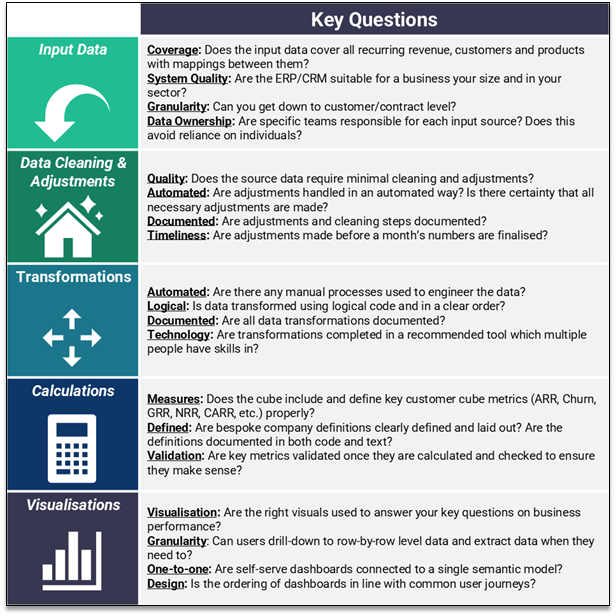INTRODUCTION
• In the rapidly evolving world of B2B SaaS businesses, the customer cube stands out as a strategically important reporting tool.
• A customer cube gives you a structured way to track your most important customer metrics, including Annual Recurring Revenue (ARR).
• A reliable customer cube is especially key for Saas companies backed by Private Equity, as investors will scrutinise these metrics rigorously during due diligence processes.
• After years of working with SaaS clients at various stages of growth, we’ve learned that pursuing “perfect” ARR reporting often becomes a barrier to meaningful progress. We believe that a better path forward is one that involves continuous evaluation and improvement.
• That’s why we’ve developed an ARR reporting scorecard that evaluates the end-to-end process of creating a reliable customer cube.
• It also helps firms understand how far they are from best practice and provides a framework for ongoing evaluation of their reporting capabilities.
THE 5-STAGE FRAMEWORK
Our scorecard is built to assess the 5 critical stages of developing a robust customer cube.
Stage 1: Input Data
All reporting solutions rely on reliable raw data with most customer cubes drawing their data from ERP and CRM systems. Quality and consistency are crucial when inputting and maintaining data, as this directly impacts all subsequent reporting stages.
Some key considerations for the input layer involve ensuring reliability of the source data, integrating systems and setting up automated validation processes.
Ask yourself: Does the input data cover all recurring revenue, customers and products with mappings between them? Are the ERP and CRM systems suitable for a business your size in your sector? Which teams are responsible for each input source?
Stage 2: Data Cleaning & Adjustments
Data from your input system rarely arrives in perfect condition. The cleaning and adjustment layer serves as the critical quality control checkpoint where errors, inconsistencies and anomalies are identified and handled. Businesses should also ensure that they have robust adjustment handling processes in place to handle known errors.
Ask yourself: Does the source data require minimal cleaning and adjustments? Are adjustments automated, and is there certainty that all necessary adjustments are made? Are cleaning and adjustment steps documented? Are adjustments made before a month’s numbers are finalised?
Stage 3: Transformation
The transformation layer is where disparate data sources are unified and restructured into a format that allows you to calculate the relevant metrics displayed on your final dashboard suite.
Ask yourself: Are there any manual processes used to engineer the data? Is data transformed using logical code and a clear order? Are all data transformations documented? Are transformations completed in a recommended tool which multiple people have skills in?
Stage 4: Calculations
This stage focuses on defining the calculations for key customer cube metrics. Beyond basic ARR calculations, this can include estimating churn and calculating metrics like GRR, NRR and CARR. The thought you put into your calculation layer directly impacts the depth and accuracy of the insights available in the final reporting solution.
Ask yourself: Are bespoke company definitions clearly defined and laid out? Are they documented in both code and text? Are key metrics validated once they are calculated and checked to ensure they make sense?
Stage 5: Visualisations
The final stage transforms calculated metrics into accessible reporting, often in the form of a dashboard. Effective visualisation goes beyond simple chart creation. It involves designing interfaces that facilitate quick decision-making while providing the flexibility to delve into detailed analysis.
Ask yourself: Are the right visuals used to answer your key questions on business performance? Can users drill down to row-by-row level data and extract it when they need to? Are self-serve dashboards connected to a single semantic model? Is the ordering of dashboards in line with common user journeys?

THE VALUE OF SYSTEMATIC ASSESSMENT
Our reporting scorecard comprises carefully crafted questions that assess each stage of the customer cube development process. These questions help businesses identify strengths, weaknesses and improvement opportunities within their existing reporting infrastructure.
The scorecard approach provides several key benefits:
Objectivity: By applying consistent evaluation criteria, businesses can objectively assess their reporting capabilities and track improvement over time. Regular assessments build confidence amongst internal teams and external stakeholders in the reliability of customer cube reporting.
Comprehensiveness: The 5-stage framework ensures no critical component of the customer cube development process is overlooked.
Actionability: Rather than simply identifying problems, the scorecard approach provides a roadmap for systematic improvement and indicates how far a business is from best practice.
EMBRACE CONTINUOUS IMPROVEMENT
The pursuit of “perfect” ARR reporting can become a barrier if it prevents businesses from implementing meaningful improvements. Our experience suggests that the most successful SaaS businesses adopt a continuous improvement mindset, regularly assessing and enhancing their customer cube, rather than waiting for perfect solutions.
This approach enables businesses to build more reliable, insightful and actionable customer cube reporting systems that evolve alongside their own growth.
MOVE FORWARD WITH CONFIDENCE
Creating a trusted customer cube requires more than technical expertise; it demands a systematic approach that addresses each stage of the reporting process with equal rigour. Our scorecard provides the framework for this systematic approach, enabling SaaS businesses to build reporting infrastructure that supports both day-to-day operations and strategic initiatives.
For Private Equity-backed businesses and those preparing for investment, this systematic approach becomes even more critical. Investors expect to see not just accurate numbers, but also evidence of robust processes that ensure continued accuracy and reliability.
At Data Vision Services, we specialise in helping B2B SaaS businesses build trusted customer cube reporting systems that drive growth and investor confidence. Our team combines deep technical expertise with practical understanding of SaaS business models to deliver reporting solutions that evolve alongside your business.
If you’re ready to transform your customer cube reporting from a technical challenge into a strategic advantage, we’d love to discuss how our scorecard approach can benefit your organisation.
Get in touch with our team today to begin your journey towards truly trusted SaaS reporting.

Sweeping US Tariffs: What This Means for the UK